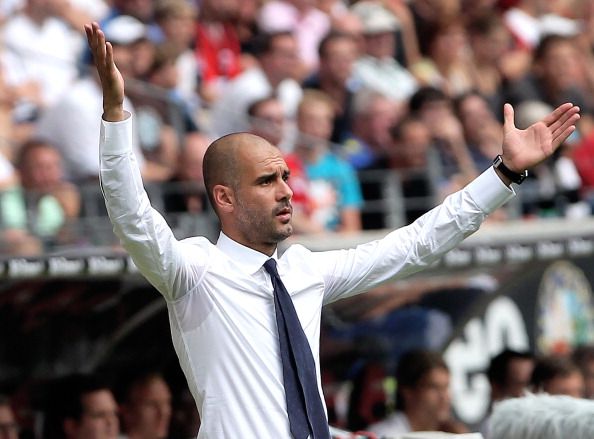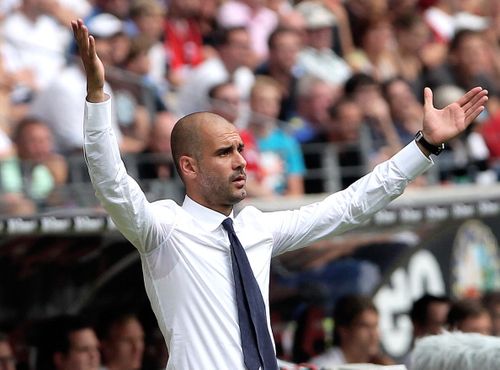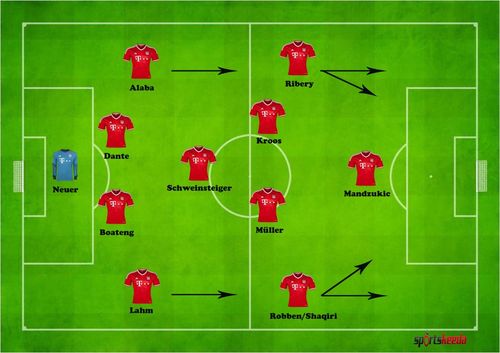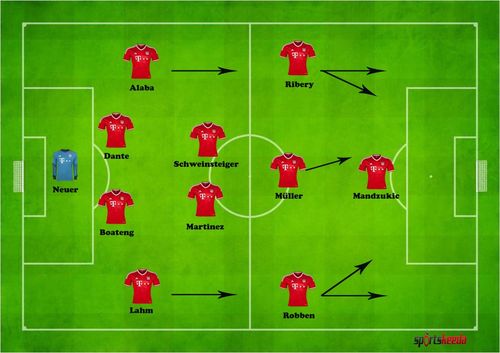
Bayern Munich and Barcelona - Tactical analysis under new managers

With the arrivals of Pep Guardiola to replace Jupp Heynckes at Bayern Munich and Gerardo Martino to take the place of Tito Vilanova at Barcelona, the two European superpowers have seen a change in their tactics and playing style. This article tries to explore what changes the new managers have tried to incorporate in the sides.
BAYERN MUNICH
The Bayern Munich team has seen a change from the 4-2-3-1 system used by Heynckes to the 4-1-4-1 one preferred by Guardiola. With the purchases of Thiago Alcantara and Mario Goetze, and the transfer of Mario Gomez to Fiorentina, Pep clearly signalled that he was looking to stack the midfield, and the 4-1-4-1 formation is suited to that strategy.

Formation of Bayern Munich team in the first two Bundesliga matches this season
Comparison of playing styles of Guardiola and Heynckes
Defence:
Guardiola’s system at Barcelona was similar to Heynckes’s at Bayern, where both promoted stifling defence, though in different ways. Guardiola’s strategy was to make the pitch as short as possible to emphasize the technical superiority of Barcelona. The centre-backs played near the midfield line, while the wing-backs were always on the lookout to advance into the opponent’s half. Whenever the ball was given away, the defenders, midfielders and even forwards would try aggressively to win the ball back, or at least force a clearance.
Bayern Munich under Heynckes played a more balanced game based on containment. The defence usually managed to comfortably keep the opponents out of the shooting range when they were in their half. It was rare to see the attackers come between the back line and goalkeeper Manuel Neuer. Similar to Guardiola’s Barcelona, every player had a role in defending. If an opponent tried to run up the flanks, the Bayern full-back and the winger and often even striker Mario Mandzukic would take him on. If the player tried to move through the centre, the entire Bayern team would descend on him to win the ball back.
Attack:
Guardiola used the possession-based style popularly called tiki-taka at Barcelona. With Xavi and Iniesta controlling the midfield, the team was able to keep possession for long periods, hence limiting the chances of the opponents. The Barca midfield would often frustrate opponents by effortlessly passing the ball in triangles near the centre line. And when they looked to attack, they would quickly make their way through opposition defences with a flurry of passes, and score goals at will.
Unlike Guardiola’s Barcelona which operated through the centre, Heynckes’ Bayern spread the ball from the centre to the flanks, and then brought the ball back to the inside again. Apart from fully leveraging the flanks, the Bayern team used a wider variety of attacking methods than Pep’s Barcelona. With the defence playing deeper, they could counter-attack more and play through the centre or out wide, using through balls, crosses and dribbling.
Comparison of Bayern Munich under Heynckes and Guardiola

The Bayern team formation preferred by Jupp Heynckes last season
The major difference between the system used by Heynckes and the one that has been employed by Guardiola thus far at Bayern Munich, is the role of the defensive midfielders.
While Heynckes used two defensive midfielders in the form of Bastian Schweinsteiger and Javi Martinez, Guardiola uses only Schweinsteiger in the role, preferring to add another midfielder in the attacking department in the form of Toni Kroos, who plays alongside Arjen Robben, Franck Ribery, Mario Goetze and Xherdan Shaqiri, depending on Guardiola’s choice. Thiago Alcantara has been purchased to play the role of midfield anchor-man, but he hasn’t got a chance to start a game in the Bundesliga yet.
Otherwise, Pep’s Bayern playing style has been a lot like the one under Heynckes. The wingers in the form of Robben and Ribery play out wide, and also cut inside to look to score goals, and the wing-backs are always on the lookout to charge into the opponent’s half. Mandzukic is preferred to play the role of the lone striker upfront.
It is still early days for Guardiola at Bayern, and though he has received some criticism for the defeat to Borussia Dortmund in the Super Cup, and also for forcing Thiago’s transfer when there wasn’t really any apparent need for the player, there is still plenty of promise on the evidence of his early results.
He has looked to experiment with his tactics in the training sessions. Striker Claudio Pizarro said: “I’ve never had a manager who changed so many things,” with right-back Philipp Lahm being tried out in the central midfield and striker Mario Mandzukic made to play on either wing. A dispatch by Der Spiegel from the Bayern Munich training camp in Italy read “Pep Guardiola turns the most successful team in the history of Bayern Munich on its head. The club’s bosses are impressed by his enthusiasm – but also worried whether everything will turn out all right.”
But as seen in the few matches, Guardiola has looked to largely continue with the playing style that brought glory to the club last season. He will certainly try to incorporate minor tweaks here and there in formations and tactics, but if his record at Barcelona is to be considered, then there is no reason why he can’t achieve success at Bayern Munich, and take the club to even higher heights than what they achieved in the 2012-13 season.